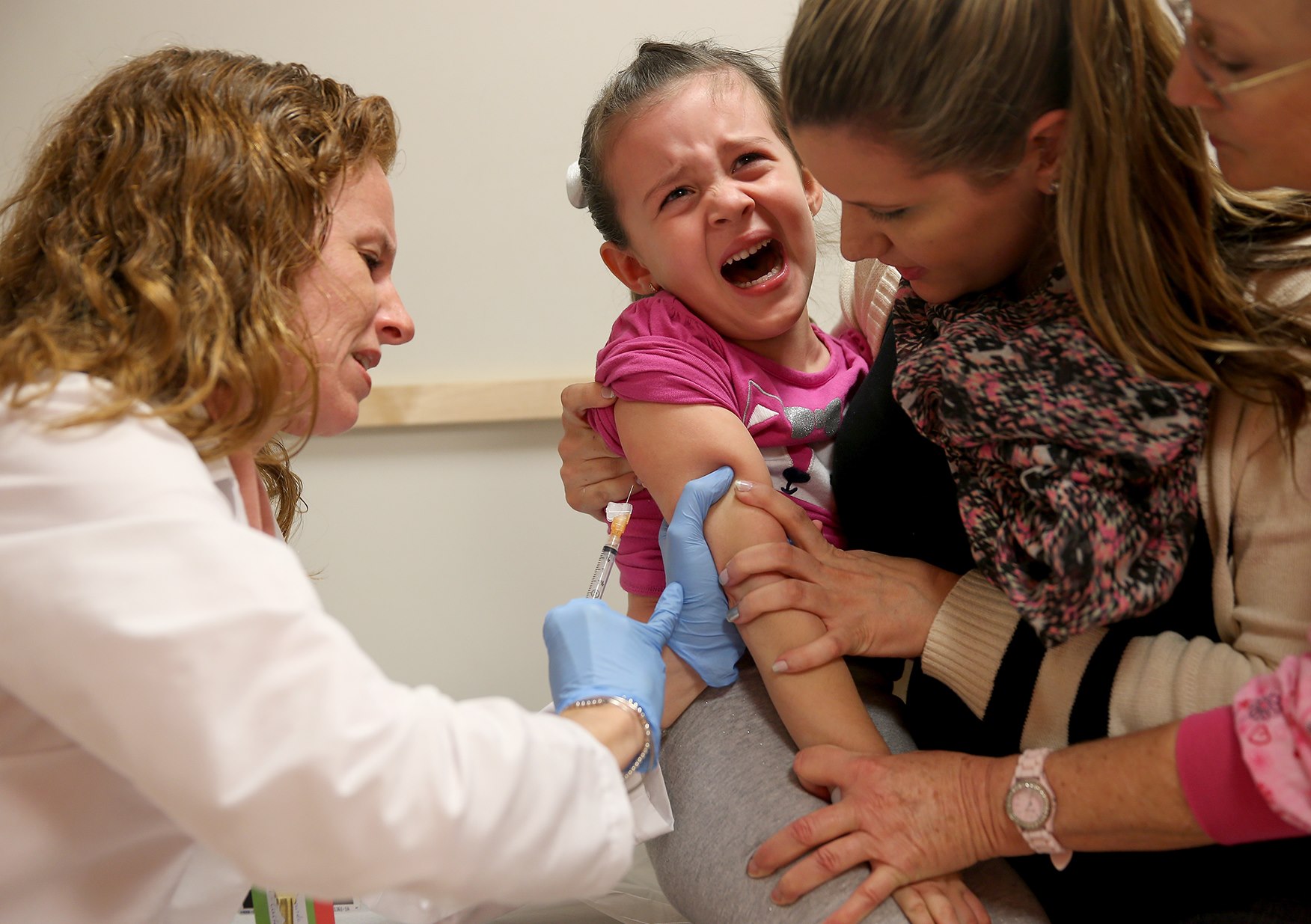Shedding light on the dark side of MMR vaccines: How vaccinated individuals SPREAD MEASLES & put the vulnerable at risk
By ljdevon // 2025-04-11
Tweet
Share
Copy

- MMR vaccine shedding may allow transmission of measles via breast milk or other routes.
- A documented case describes a vaccinated woman contracting measles 9 weeks post-vaccination.
- A documented case of a teenager dying after contracting vaccine-strain measles
- 32% of 14-18 month olds experience moderate-to-severe fever, raising safety concerns.
- Recent outbreaks may stem from vaccine-driven viral spread, contradicting official narratives.
Vaccinated individuals can spread the very diseases they are inoculated against
The trust in vaccines as a cornerstone of public health is being shattered by emerging revelations about the MMR vaccine. While hailed as a savior against measles, mumps, and rubella, scientific scrutiny exposes unsettling truths: vaccinated individuals may unknowingly spread the very diseases they were inoculated against. This is mentioned on the vaccine insert sheet for Merck's MMR II. Recent studies, including a harrowing case of a 40-year-old woman hospitalized with vaccine-derived measles, and a study on the death of a 17-year-old, immunocompromised child, now force us to question the true risks of these live virus injections—and the cover-ups that fuel vaccine propaganda. The MMR vaccine, though widely distributed, carries little-disclosed dangers: contraindications for pregnant women, immune-compromised individuals, and those with allergies, as well as side effects so severe that 1 in 3 children run high fevers. Even more alarming, evidence suggests the vaccine virus can spread among the vaccinated, particularly through breast milk—a fact pharmaceutical companies downplay. In an era of renewed measles outbreaks, the question arises: are officials blaming unvaccinated populations while ignoring the potential role of vaccinated carriers?The phantom in the vaccinated: shedding and silent spread
Live attenuated vaccines like MMR are designed to stimulate immune responses by introducing weakened viruses. But what happens when these viruses don’t stay “weakened”? Research reveals that lactating mothers receive the M-M-R II vaccine may inadvertently infect their nursing babies with rubella via breast milk. Though rare, such cases have been documented, with infants showing mild rubella-like illnesses. The Centers for Disease Control (CDC) admits, in fine print, that “rubella virus strains [in MMR] have been transmitted to infants,” yet public warnings are absent. Now, the specter of measles shedding further complicates the narrative. A Canadian case study details a 40-year-old woman—never vaccinated as a child—who received an MMR shot nine weeks before childbirth. Ten days later, she developed a rash, fever, and symptoms indistinguishable from wild-type measles. Lab tests confirmed the disease originated from the vaccine strain despite negative prenatal antibodies. “This isn’t a theoretical risk—it’s happening,” says an immunologist who reviewed the case. “Vaccine-derived measles can resemble the ‘wild’ form and may spread to unvaccinated infants in close contact.” The case underscores a chilling reality: vaccinated individuals might harbor and transmit live viruses, particularly in households with newborns too young for vaccines. Public health advisories focus on vaccinating everyone, yet the dangers of “vaccine strain” shedding remain buried. The 28-day “safety window” touted by health agencies is increasingly undermined by evidence that immunity gaps persist.Vaccine associated measles in 17-year-old with Hodgkin's lymphoma
This case study reports a rare and fatal instance of vaccine-associated measles in a 17-year-old girl with Hodgkin’s lymphoma, highlighting critical risks associated with live attenuated vaccines in immunocompromised individuals. The patient received the MMR vaccine while in a U.S. detention facility, prior to being diagnosed with stage IIA Hodgkin’s lymphoma. After chemotherapy induced severe immunosuppression, she developed disseminated measles infection from the vaccine strain, confirmed post-mortem via histopathology, RT-PCR, and genotyping. Despite broad infectious workups and aggressive treatment, she succumbed to respiratory failure three months after vaccination. The case underscores the extreme rarity of such outcomes but stresses the importance of rigorous pre-vaccination screening for immunodeficiencies, including recent or concurrent malignancies. While the MMR vaccine has nearly eradicated endemic measles in the U.S., its live components pose unique risks to those with weakened immunity.The outbreak paradox: Are vaccine campaigns fanning the flames?
Mainstream media consistently blame measles resurgence on the “anti-vaxxer” movement, but could campaigns themselves contribute? If vaccinated individuals can shed vaccine strains, even temporarily, populations with high vaccination rates might still harbor undetectable outbreaks. Consider this: the 40-year-old’s infant was never exposed to wild-type virus but was in close contact during her mother’s illness. If intentional withholding of breastfeeding lasted only during symptoms, transmission potential remains. This challenges assumptions that vaccines create “herd immunity”—if vaccinated shedders outpace wild outbreaks, standard metrics fail completely. The MMR’s own prescribing guidelines admit that fierce fevers (32% in infants), febrile seizures, and even neurological damage may occur. Yet, public campaigns dismiss such risks as “rare” while obscuring statistics. For example, the 2016 study mentioned in the case report found no evidence of vaccine transmission—yet that very year, the Canadian case proved it possible. It's important to note that pharmaceutical giants like Merck profit handsomely from repeated “booster” dose recommendations. If immune protection wanes after vaccination, pushing more doses perpetuates sales—and may fuel genetic evolution of vaccine-resistant strains. As the MMR’s hidden risks surface, one metaphor comes to mind: the snake eating its own tail. Vaccines designed to eradicate disease instead sustain cycles of viral transmission, vaccine mandates drive profits, and vulnerable populations—like newborns, lactating mothers, and the immunocompromised—pay the price. Sources include: X.com Merck.com Pubmed.gov NEJM.org Pubmed.govTweet
Share
Copy
Tagged Under:
autism breast milk MMR vaccine Public Health measles vaccine safety immunization Clinical trials newborns Dangerous Medicine adverse reactions vaccine efficacy independent research outbreaks medical violence rubella viral shedding badhealth badmedicine infection control vaccine hesitancy fever health policy immunocompromised immunization schedules IgM responses lactating women vaccine-associated measles postpartum vaccination molecular testing vaccine contraindications
You Might Also Like
Suspect admits targeting Pennsylvania governor in arson attack
By Cassie B. // Share
Walmart celery recall raises new concerns about corporate food safety failures
By Cassie B. // Share
Recent News
Zelensky extends martial law again, delaying elections amid legitimacy concerns
By isabelle // Share
Trump’s tariff policies trigger global economic decoupling: Health Ranger warns of U.S. collapse
By finnheartley // Share
How Vitamins D and B12 could be the missing link in preventing dementia
By isabelle // Share









